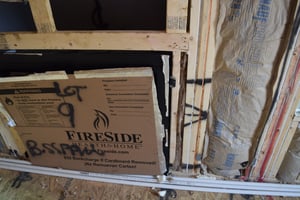In our effort to help builders and contractors reduce air leakage in new construction homes, much of the focus has been on the building envelope. However, there are other areas outside of the building envelope that can prove problematic for air leakage. Bob Nelson of Ener-G Home Performance Consultants shed some light on three commonly overlooked areas that can contribute considerably to air leakage and often, help contribute to the 50 percent initial failure rate on blower door testing of new homes.
- Bath Fans
Nelson says the exhaust portion of the fan has a back-flow prevention device on the fan unit and some are missing when they are installed. His guidance to builders is simple, “make sure that back flow device is installed, and where the vent pipe leaves the exterior of the house, make sure the wall vent cap also has a back-flow device.” Nelson notes that far too often he sees air flowing through the bath fans back into the home when he conducts blower door tests for building tightness. “When the HVAC system comes on, any homeowner will feel the outside air coming back into the house.”
- Fireplace Inserts
 The three sides of the exterior fireplace must be properly air sealed and insulated. This area should be airtight, or the air will penetrate around the fireplace unit and into the conditioned space. Getting the fireplace insert right requires following the instructions for the unit, which will include specific guidance on proper installation as well as details on how to treat air sealing and insulation around the unit to ensure safe operation. (Pictured at right, a fireplace including air sealing and insulation.)
The three sides of the exterior fireplace must be properly air sealed and insulated. This area should be airtight, or the air will penetrate around the fireplace unit and into the conditioned space. Getting the fireplace insert right requires following the instructions for the unit, which will include specific guidance on proper installation as well as details on how to treat air sealing and insulation around the unit to ensure safe operation. (Pictured at right, a fireplace including air sealing and insulation.)
- Sprinkler Heads
Most raters and inspectors require that the sprinkler pipes in attics be under the thermal barrier in the attic for the colder climate areas. This keeps pipes from potentially freezing, but all too often, the space around the sprinkler head is not properly sealed and 20 to 30 sprinkler heads missing air sealing can add up. Nelson advised that builders consult with the sprinkler manufacturer to understand their product and how to achieve an air tight seal with the ceiling. “Understanding the manufacturer’s installation requirements will help ensure that air sealing is handled properly while also ensuring that the sprinkler head performs as it was designed.”
The Importance of Quality Assurance
A laser focus on the building envelope while ignoring other areas of potentially significant air leakage can cause serious moisture and comfort problems for the homeowners. In the best cases, builders have a quality assurance process in place and have empowered either the superintendent or HERS rater to be the quality leader, conducting walk through inspections to check for air sealing of all penetrations that would allow air flow. Having a quality control process in place can help assure a tightly sealed home and happy, comfortable homeowners.





